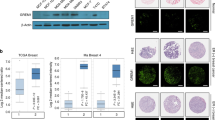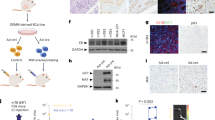Abstract
Aberrant constitutive expression of c-Rel, p65 and p50 NF-κB subunits has been reported in over 90% of breast cancers1,2. Recently, we characterized a de novo RelB NF-κB subunit synthesis pathway, induced by the cytomegalovirus (CMV) IE1 protein, in which binding of p50–p65 NF-κB and c-Jun–Fra-2 AP-1 complexes to the RELB promoter work in synergy to potently activate transcription3. Although RelB complexes were observed in mouse mammary tumours induced by either ectopic c-Rel expression4 or carcinogen exposure5, little is known about RelB in human breast disease. Here, we demonstrate constitutive de novo RelB synthesis is selectively active in invasive oestrogen receptor alpha (ERα)-negative breast cancer cells. ERα signalling reduced levels of functional NF-κB and Fra-2 AP-1 and inhibited de novo RelB synthesis, leading to an inverse correlation between RELB and ERα gene expression in human breast cancer tissues and cell lines. Induction of Bcl-2 by RelB promoted the more invasive phenotype of ERα-negative cancer cells. Thus, inhibition of de novo RelB synthesis represents a new mechanism whereby ERα controls epithelial to mesenchymal transition (EMT).
This is a preview of subscription content, access via your institution
Access options
Subscribe to this journal
Receive 12 print issues and online access
$209.00 per year
only $17.42 per issue
Buy this article
- Purchase on Springer Link
- Instant access to full article PDF
Prices may be subject to local taxes which are calculated during checkout





Similar content being viewed by others
References
Nakshatri, H., Bhat-Nakshatri, P., Martin, D. A., Goulet, R. J., Jr. & Sledge, G. W., Jr. Constitutive activation of NF-kappaB during progression of breast cancer to hormone-independent growth. Mol. Cell. Biol. 17, 3629–3639 (1997).
Sovak, M. A. et al. Aberrant nuclear factor-kappaB/Rel expression and the pathogenesis of breast cancer. J Clin. Invest. 100, 2952–2960 (1997).
Wang, X. & Sonenshein, G. E. Induction of the RelB NF-kappaB subunit by the cytomegalovirus IE1 protein is mediated via Jun kinase and c-Jun/Fra-2 AP-1 complexes. J. Virol. 79, 95–105 (2005).
Romieu-Mourez, R. et al. Mouse mammary tumor virus c-rel transgenic mice develop mammary tumors. Mol. Cell Biol. 23, 5738–5754 (2003).
Demicco, E. G. et al. RelB/p52 NF-kappaB complexes rescue an early delay in mammary gland development in transgenic mice with targeted superrepressor IkappaB-alpha expression and promote carcinogenesis of the mammary gland. Mol. Cell Biol. 25, 10136–10147 (2005).
van de Vijver, M. J. et al. A gene-expression signature as a predictor of survival in breast cancer. N. Engl. J. Med. 347, 1999–2009 (2002).
Wang, Y. et al. Gene-expression profiles to predict distant metastasis of lymph-node-negative primary breast cancer. Lancet 365, 671–679 (2005).
Philips, A. et al. FRA-1 expression level modulates regulation of activator protein-1 activity by estradiol in breast cancer cells. Mol. Endocrinol. 12, 973–985 (1998).
Romieu-Mourez, R. et al. Roles of IKK kinases and protein kinase CK2 in activation of nuclear factor-kappaB in breast cancer. Cancer Res. 61, 3810–3818 (2001).
Hyder, S. M., Chiappetta, C., Murthy, L. & Stancel, G. M. Selective inhibition of estrogen-regulated gene expression in vivo by the pure antiestrogen ICI 182,780. Cancer Res. 57, 2547–2549 (1997).
Oliveira, C. A. et al. The antiestrogen ICI 182,780 decreases the expression of estrogen receptor-alpha but has no effect on estrogen receptor-beta and androgen receptor in rat efferent ductules. Reprod. Biol. Endocrinol. 1, 75 (2003).
Kalaitzidis, D. & Gilmore, T. D. Transcription factor cross-talk: the estrogen receptor and NF-kappaB. Trends Endocrinol. Metab. 16, 46–52 (2005).
Horwitz, K. B. Mechanisms of hormone resistance in breast cancer. Breast Cancer Res. Treat. 26, 119–130 (1993).
Johnston, S. R. et al. Changes in estrogen receptor, progesterone receptor, and pS2 expression in tamoxifen-resistant human breast cancer. Cancer Res. 55, 3331–3338 (1995).
Rochefort, H. et al. Estrogen receptor mediated inhibition of cancer cell invasion and motility: an overview. J. Steroid Biochem. Mol. Biol. 65, 163–168 (1998).
Catz, S. D. & Johnson, J. L. Transcriptional regulation of bcl-2 by nuclear factor kappa B and its significance in prostate cancer. Oncogene 20, 7342–7351 (2001).
Xiang, H., Wang, J. & Boxer, L. M. Role of the cyclic AMP response element in the bcl-2 promoter in the regulation of endogenous Bcl-2 expression and apoptosis in murine B cells. Mol. Cell Biol. 26, 8599–8606 (2006).
Mehlen, P. & Puisieux, A. Metastasis: a question of life or death. Nature Rev. Cancer 6, 449–458 (2006).
Burkly, L. et al. Expression of relB is required for the development of thymic medulla and dendritic cells. Nature 373, 531–536 (1995).
Stoffel, A., Chaurushiya, M., Singh, B. & Levine, A. J. Activation of NF-kappaB and inhibition of p53-mediated apoptosis by API2/mucosa-associated lymphoid tissue 1 fusions promote oncogenesis. Proc. Natl Acad. Sci. USA 101, 9079–9084 (2004).
Lessard, L., Begin, L. R., Gleave, M. E., Mes-Masson, A. M. & Saad, F. Nuclear localisation of nuclear factor-kappaB transcription factors in prostate cancer: an immunohistochemical study. Br. J. Cancer 93, 1019–1023 (2005).
Josson, S. et al. RelB regulates manganese superoxide dismutase gene and resistance to ionizing radiation of prostate cancer cells. Oncogene 25, 1554–1559 (2006).
Van Laere, S. J. et al. Nuclear factor-kappaB signature of inflammatory breast cancer by cDNA microarray validated by quantitative real-time reverse transcription-PCR, immunohistochemistry, and nuclear factor-kappaB DNA-binding. Clin. Cancer Res. 12, 3249–3256 (2006).
Huber, M. A. et al. NF-kappaB is essential for epithelial–mesenchymal transition and metastasis in a model of breast cancer progression. J. Clin. Invest. 114, 569–581 (2004).
Shin, S. R., Sanchez-Velar, N., Sherr, D. H. & Sonenshein, G. E. 7,12-dimethylbenz(a)anthracene treatment of a c-rel mouse mammary tumor cell line induces epithelial to mesenchymal transition via activation of nuclear factor-kappaB. Cancer Res. 66, 2570–2575 (2006).
Schmitt, C. A. et al. Dissecting p53 tumor suppressor functions in vivo. Cancer Cell 1, 289–298 (2002).
de Moissac, D., Mustapha, S., Greenberg, A. H. & Kirshenbaum, L. A. Bcl-2 activates the transcription factor NFkappaB through the degradation of the cytoplasmic inhibitor IkappaBalpha. J. Biol. Chem. 273, 23946–23951 (1998).
Fujita, N. et al. MTA3, a Mi-2/NuRD complex subunit, regulates an invasive growth pathway in breast cancer. Cell 113, 207–219 (2003).
Guo, S. & Sonenshein, G. E. Forkhead box transcription factor FOXO3a regulates estrogen receptor alpha expression and is repressed by the Her-2/neu/phosphatidylinositol 3-kinase/Akt signaling pathway. Mol. Cell Biol. 24, 8681–8690 (2004).
Philips, A., Chalbos, D. & Rochefort, H. Estradiol increases and anti-estrogens antagonize the growth factor-induced activator protein-1 activity in MCF7 breast cancer cells without affecting c-fos and c-jun synthesis. J. Biol. Chem. 268, 14103–14108 (1993).
Romieu-Mourez, R., Landesman-Bollag, E., Seldin, D. C. & Sonenshein, G. E. Protein kinase CK2 promotes aberrant activation of nuclear factor-kappaB, transformed phenotype, and survival of breast cancer cells. Cancer Res. 62, 6770–6778 (2002).
Min, C. et al. The tumor suppressor activity of the lysyl oxidase pro-peptide reverses invasive phenotype of Her-2/neu driven breast cancer. Cancer Res. 67, 1105–1112 (2007).
Schjerven, H., Tran, T. N., Brandtzaeg, P. & Johansen, F. E. De novo synthesized RelB mediates TNF-induced up-regulation of the human polymeric Ig receptor. J. Immunol. 173, 1849–57 (2004).
Sentman, C. L., Shutter, J. R., Hockenbery, D., Kanagawa, O. & Korsmeyer, S. J. Bcl-2 inhibits multiple forms of apoptosis but not negative selection in thymocytes. Cell 67, 879–888 (1991).
Freund, A. et al. Mechanisms underlying differential expression of interleukin-8 in breast cancer cells. Oncogene 23, 6105–6114 (2004).
Acknowledgements
We thank F.-E. Johansen, C. V. Paya, S. Korsmeyer and L. M. Boxer for cloned DNAs, T. Akagi for the inducible retroviral vector, and P. Leder for the NF639 cell line. These studies were supported by National Institute of Health (NIH) grants ES11624 and CA36355.
Author information
Authors and Affiliations
Corresponding author
Ethics declarations
Competing interests
The authors declare no competing financial interests.
Supplementary information
Supplementary Information
Supplementary figures S1, S2, S3, S4 and S5 (PDF 289 kb)
Rights and permissions
About this article
Cite this article
Wang, X., Belguise, K., Kersual, N. et al. Oestrogen signalling inhibits invasive phenotype by repressing RelB and its target BCL2. Nat Cell Biol 9, 470–478 (2007). https://doi.org/10.1038/ncb1559
Received:
Accepted:
Published:
Issue Date:
DOI: https://doi.org/10.1038/ncb1559
This article is cited by
-
Role of Fra-2 in cancer
Cell Death & Differentiation (2024)
-
Estrogen/ER in anti-tumor immunity regulation to tumor cell and tumor microenvironment
Cancer Cell International (2021)
-
New insights into antimetastatic signaling pathways of melatonin in skeletomuscular sarcoma of childhood and adolescence
Cancer and Metastasis Reviews (2020)
-
Alternative NF-κB signaling promotes colorectal tumorigenesis through transcriptionally upregulating Bcl-3
Oncogene (2018)
-
Chromosomal instability drives metastasis through a cytosolic DNA response
Nature (2018)



